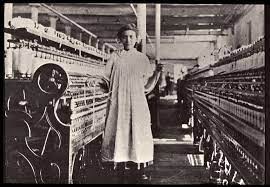The Lowell Mills: The Mill Girls
Introduction
Text-to-speech Audio
In 1835 the town of Lowell, Massachusetts opened its first large industrial textile mill along the Merrimack River. Called the Boott Cotton Mills, its success instituted a chain reaction for 10 other major textile corporations to open 50 factories along the river, making Lowell one of the most successfully industrialized cities in the American Industrial Revolution. There were many factors that made the textile industry in this area very profitable, such as technological advancements, but another reason was the cheap labor available in the area. Men, women, and children were all used at this time as employees of the factories. They were willing to work long, grueling hours to make any sort of wage because this was a time where any money was better than no money. Women were the original workers of the mills, known as the “Mill Girls,” made history from their work in the factories and their lives outside them as well. Women worked in these factories until their closure in the mid 1920’s, when legislation restricting working hours hindered the company’s profits and caused their relocation to the south.
Images
A picture of a Mill Girl working in the Lowell Mills.

The Boott Cotton Mills today, turned into condo units.

A picture of a group of the Lowell Mill Girls

The present day Boott Cotton Mills, made into the Boott Cotton Mills Museum

Backstory and Context
Text-to-speech Audio
Women were given the opportunity to work because of the American Industrial Revolution’s demand for labor. As industries were becoming more technologically advanced, productivity increased. In the Lowell textile mills, the development of new spinning machines in the large factories increased productivity of turning raw cotton into fine cloth. Women were the first ones to work in the mills, because in Waltham, Massachusetts a group of Yankee Women had proved to be a source of cheap and good workers on the farms. The companies were prepared to provide food and housing to their women employees. As the demand for their high-end product increased, the number of workers required increased. Women got more opportunities over time after the fight against child labor arose, and therefore someone needed to take their place.
At this time, women were a marginalized population, and even more so were the women that immigrated to Lowell to find a job in the factories they had heard about. The Mill Girls worked and lived closely together and formed lasting friendship bonds, and it gave them a sense that they had value in society as a group. Their jobs required 12–14-hour days of grueling work. The factories were hot, the machines were dangerous, and the roar of the machines was deafening. Even in these unfavorable conditions, the women that worked needed the wage and housing to sustain themselves and their families and endured it.
On multiple occasions, the Mill Girls rose and fought against the workplace injustices they endured. The women were underestimated, and when their pay was cut in 1834, they “turned-out”, and went on strike against their bosses. They did not accomplish anything financially, even when they did it again in 1836. This Union for Working Women shifted into political action when they realized they could not accomplish anything directly with their bosses. They fought for legislation for 10-day work hours, and again it proved to be ineffective. Even with their persistent resistance they did not get fired, for their labor was too valuable to the company owners. Although the women could not change their current situations with their protest, they set examples for women in the future of fighting for their rights.
Without women in the textile workforce, the American Industrial Revolution would not have progressed as quickly and effectively as it did. Due to companies being able to exploit their women employees and subject them to long hours and low wages, they were able to profit exceptionally. The large textile companies that took up residence in Lowell provided schools, churches, libraries, and housing for these workers. In the little time they had off, women had access to all these things. The population of Lowell increased from 2500 to around 33,000 after the industrialization of the town. The success the textile industry saw here was cause for expansion. The factories were powered by the hydropower of the Merrimack River, and it eventually led to the building of 7 more canals to power each facility.
The Lowell Mills closed in the 1920’s once Massachusetts passed legislation limiting working hours and increasing minimum wage for the factory workers. Unlike the past, these laws were enforced and in return caused a decline in company profits. The industry responded by moving their factories to the South where no such laws were in place, and they could profit as they were before. The Mill Girls were out of work, and after that the mills never re opened. In Lowell today, the buildings have been re-purposed. Some buildings became apartments, and there is even a museum open. The museum commemorating the history of the mills is called the “Boott Cotton Mills Museum,” after the first company to open. At this museum you will find history of the controversial child labor as well as economic information, and the technological advancements. However, to learn about the women that worked in the mills you must go to a separate museum, the Mogan Cultural Center. It details history the immigrants of Lowell, and there is where you find a history of the Mill Girls.
Sources
“Building America’s Industrial Revolution: The Boott Cotton Mills of Lowell, Massachusetts.” National Park Service. U.S. Department of the Interior, July 8, 2021. https://www.nps.gov/articles/building-america-s-industrial-revolution-the-boott-cotton-mills-of-lowell-massachusetts-teaching-with-historic-places.htm
“The Mill Girls of Lowell.” National Park Service. U.S. Department of the Interior, November 15, 2018. https://www.nps.gov/lowe/learn/historyculture/the-mill-girls-of-lowell.htm
“Lowell Mill Women Create the First Union of Working Women.” Alf-Cio. American Federation of Labor and Congress of Industrial Organizations, 2021. https://aflcio.org/about/history/labor-history-events/lowell-mill-women-form-union
https://resources.sun-associates.com/mercer/handouts/millgirls.html
https://www.maloneyrealestate.com/condo-developments/boott-mills-condos-lowell-ma
https://www.nps.gov/lowe/learn/historyculture/the-mill-girls-of-lowell.htm
https://npplan.com/parks-by-state/massachusetts-national-parks/lowell-national-historical-park-park-at-a-glance/lowell-national-historical-park-museums-and-exhibits/lowell-national-historical-park-boott-cotton-mills-museum/
